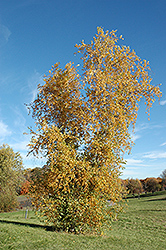Height: 30 feet
Spread: 20 feet
Sunlight:
![]()
Hardiness Zone: 3
Other Names: Poplar Birch, Field Birch
Description:
One of the smaller native birches, this small tree is ideal for the woodland or naturalized setting as it tends to slowly spread into colonies by suckering; good fall color, very adaptable to both wet and dry sites
Ornamental Features
Gray Birch has dark green deciduous foliage on a tree with an oval habit of growth. The glossy pointy leaves turn an outstanding yellow in the fall. The smooth creamy white bark adds an interesting dimension to the landscape.
Landscape Attributes
Gray Birch is an open deciduous tree with a shapely oval form. Its relatively fine texture sets it apart from other landscape plants with less refined foliage.
This is a relatively low maintenance tree, and should only be pruned in summer after the leaves have fully developed, as it may 'bleed' sap if pruned in late winter or early spring. Gardeners should be aware of the following characteristic(s) that may warrant special consideration;
- Suckering
- Insects
Gray Birch is recommended for the following landscape applications;
- Shade
- Naturalizing And Woodland Gardens
Planting & Growing
Gray Birch will grow to be about 30 feet tall at maturity, with a spread of 20 feet. It has a low canopy with a typical clearance of 4 feet from the ground, and should not be planted underneath power lines. It grows at a fast rate, and under ideal conditions can be expected to live for approximately 30 years.
This tree should only be grown in full sunlight. It is an amazingly adaptable plant, tolerating both dry conditions and even some standing water. It is very fussy about its soil conditions and must have poor, acidic soils to ensure success, and is subject to chlorosis (yellowing) of the foliage in alkaline soils. It is quite intolerant of urban pollution, therefore inner city or urban streetside plantings are best avoided, and will benefit from being planted in a relatively sheltered location. This species is native to parts of North America.
